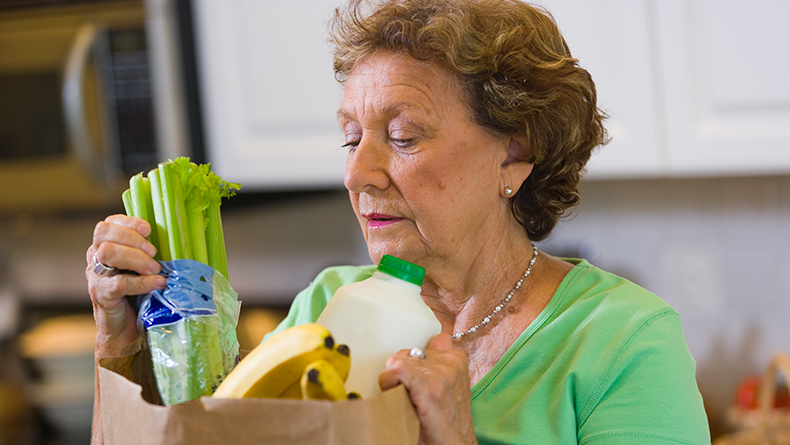AARP Hearing Center
Strengthening SNAP to Combat High Food Insecurity
By Olivia Dean, November 14, 2024 09:13 AM

“If it wasn’t for SNAP, I don’t know what we would do.” – 61-year-old AARP survey participant
In 2023, 12.6 million – or over one in 10 – adults ages 50 and older were food insecure, meaning they had limited or uncertain access to adequate food. Following a decade of downward trends in food insecurity, the share of older adults who were food insecure grew by 2.5 percentage points between 2021 and 2023 (see figure), equal to 3.2 million additional people. This rise highlights the importance of ensuring that the Supplemental Nutrition Assistance Program (SNAP) – formerly known as food stamps – can keep doing its job.

What’s behind the trend
Higher rates of food insecurity in 2022 and 2023 could be due to a number of reasons. Inflation is likely one factor. Food prices rose by nearly 10 percent in 2022, though food price growth slowed to 5.8 percent in 2023. AARP and Mathematica research found that expenses outpace income among low-income 50+ households, with food representing one of the largest categories of spending. Facing high prices, older adults may resort to making difficult trade-offs between food and other basic needs. Fortunately, the latest data shows food prices have continued to decelerate in 2024.
Another factor could be the end of various COVID-era relief measures, including COVID-era emergency allotments for people participating in SNAP. SNAP provides a monthly benefit to eligible low-income households to purchase food. Starting in March 2020, all SNAP participants began receiving temporary emergency allotments that supplemented their regular SNAP benefits. In FY 2022, SNAP households with adults ages 50 and older received an average $185 in regular monthly benefits – but including emergency allotments, that average totaled $321. Most states still provided the extra allotments in 2022, but all states had ended them by March 2023. At the same time, other COVID-related waivers and expansions were ending, such as the prohibition on states disenrolling anyone from Medicaid. Nearly 2 million adults ages 50 to 64 were estimated to have lost Medicaid coverage by the end of August 2024 due to redeterminations. Loss of various benefits could be making it harder for people to put food on the table.
SNAP lifts millions of older adults out of food insecurity and poverty
SNAP is one of the most important programs for alleviating food insecurity, reducing food insecurity by as much as 30 percent and lifting millions out of poverty. Our new report finds that SNAP benefits alone augmented income enough to lift nearly one in five – or 1.8 million – SNAP households with adults ages 50 and older out of poverty in FY 2022. When the emergency allotments of recent years are added to the mix, the impact is even greater. Regular SNAP benefits plus emergency allotments moved 35 percent of older households – or nearly 3.5 million households – above the poverty level.

Addressing food insecurity requires protecting and strengthening SNAP
Strengthening SNAP is an important step in addressing rising rates of food insecurity. First, policymakers should ensure benefits are adequate. One in six older SNAP households received the minimum benefit of $20 a month in 2022, which would have covered only about five meals. Increasing the minimum benefit could improve benefit adequacy and may incentivize more eligible older adults – who have disproportionately low SNAP participation – to enroll in the program. In fact, research has found many eligible older adults don’t enroll due to the expectation of low benefit levels. Regularly reevaluating the Thrifty Food Plan, which is the basis for calculating SNAP benefits, is also important to ensuring benefits align with actual food costs. SNAP allows certain income deductions that can increase benefit amounts, and our research has found some deductions could be adjusted to better account for older adults’ expenses, including housing, transportation, and medical costs.
Policymakers should also pursue efforts to make it easier for eligible older adults to participate in SNAP, such as through streamlining and simplifying SNAP processes and promoting coordination and data sharing between federal low-income programs to allow older adults to easily enroll in all the programs they are eligible for.
Efforts to strengthen SNAP should go hand in hand with support for other nutrition programs targeting older adults, such as the Older Americans Act nutrition programs (home-delivered and congregate meals), the Commodity Supplemental Food Program, and the Senior Farmers’ Market Nutrition Program. At the same time, policymakers should work across sectors to address the root causes of food insecurity among older adults – including poverty, low wages and unaffordable housing. A mix of downstream and upstream interventions will make the largest impact on reducing food insecurity.
































































